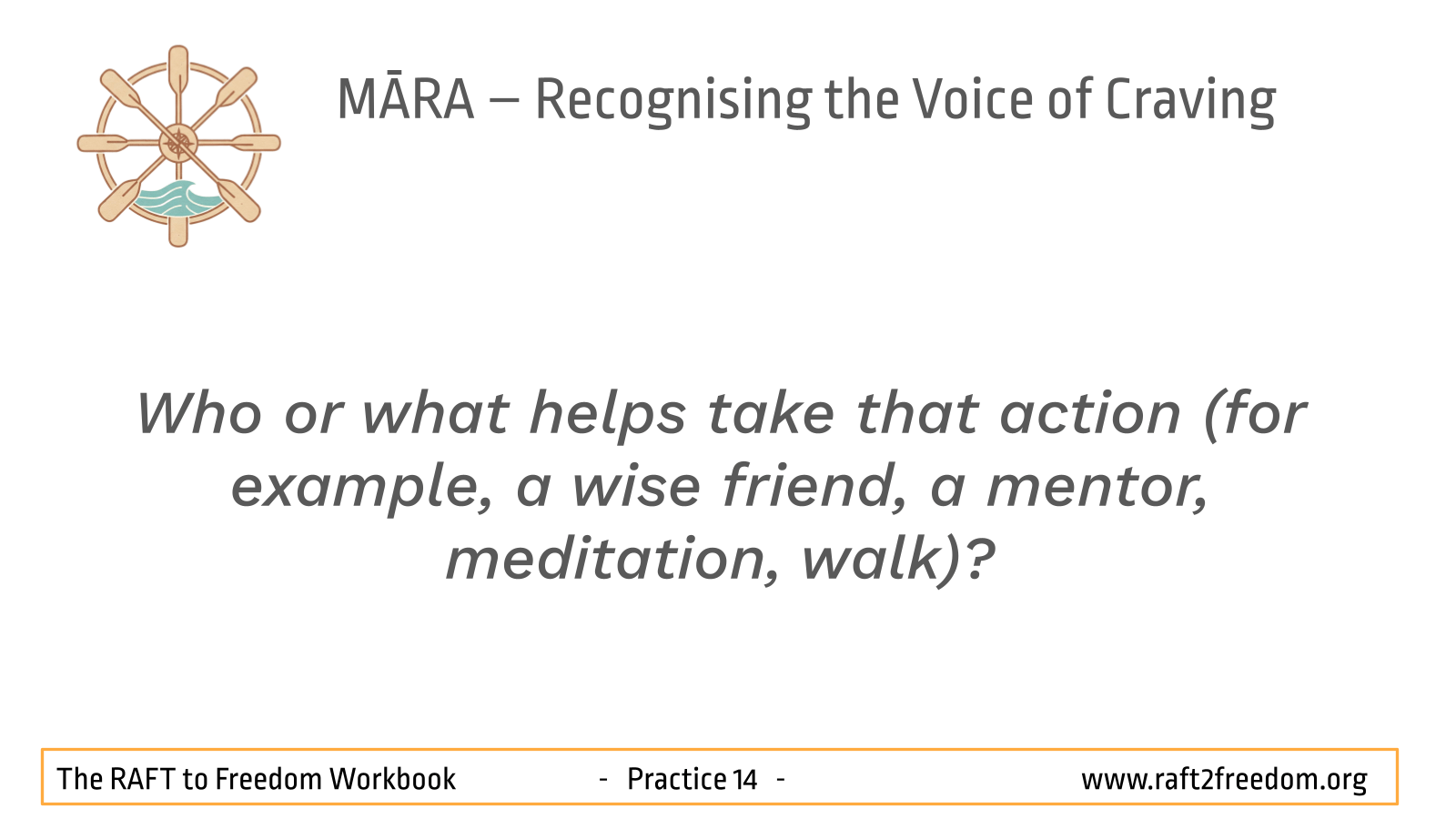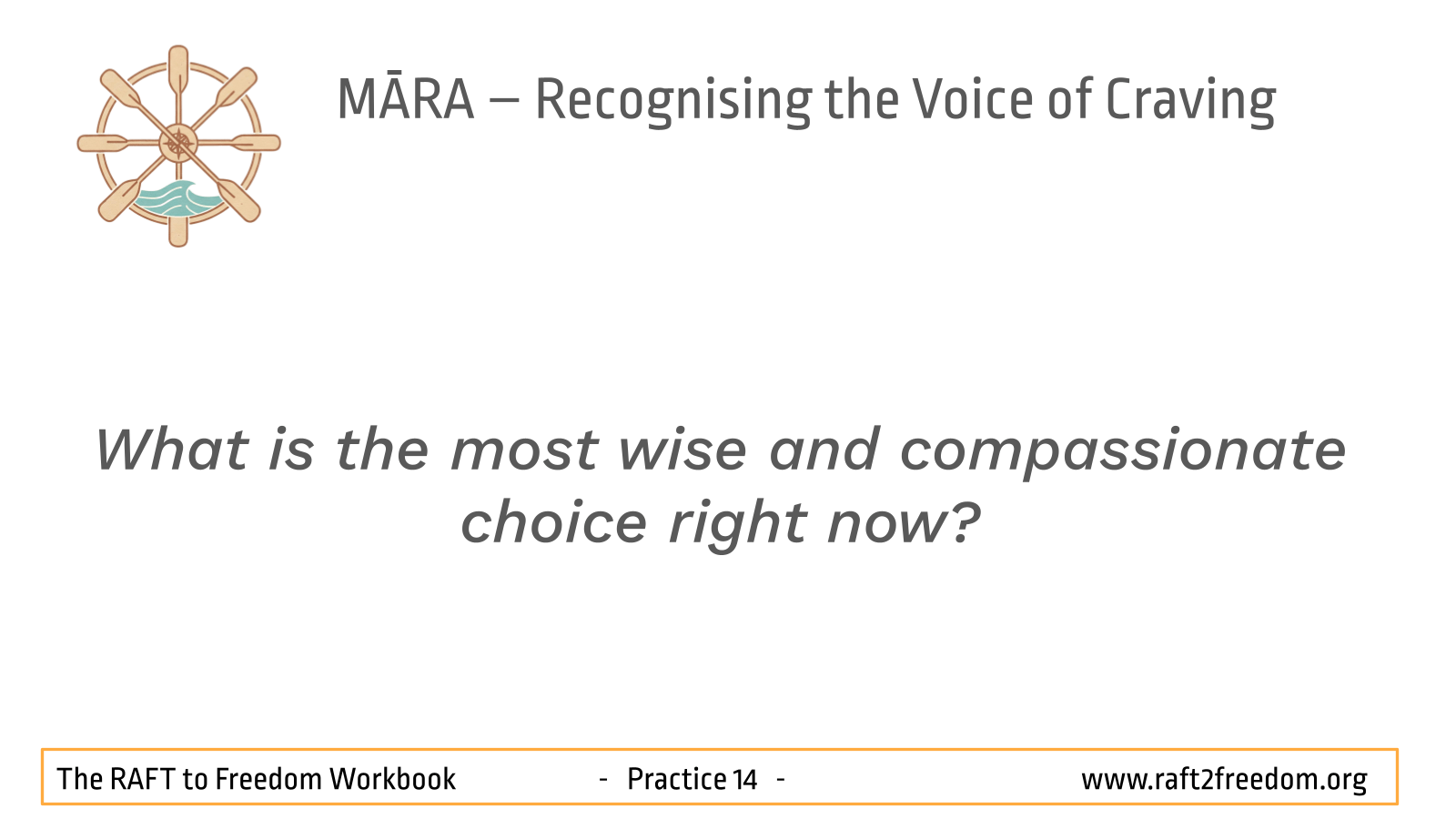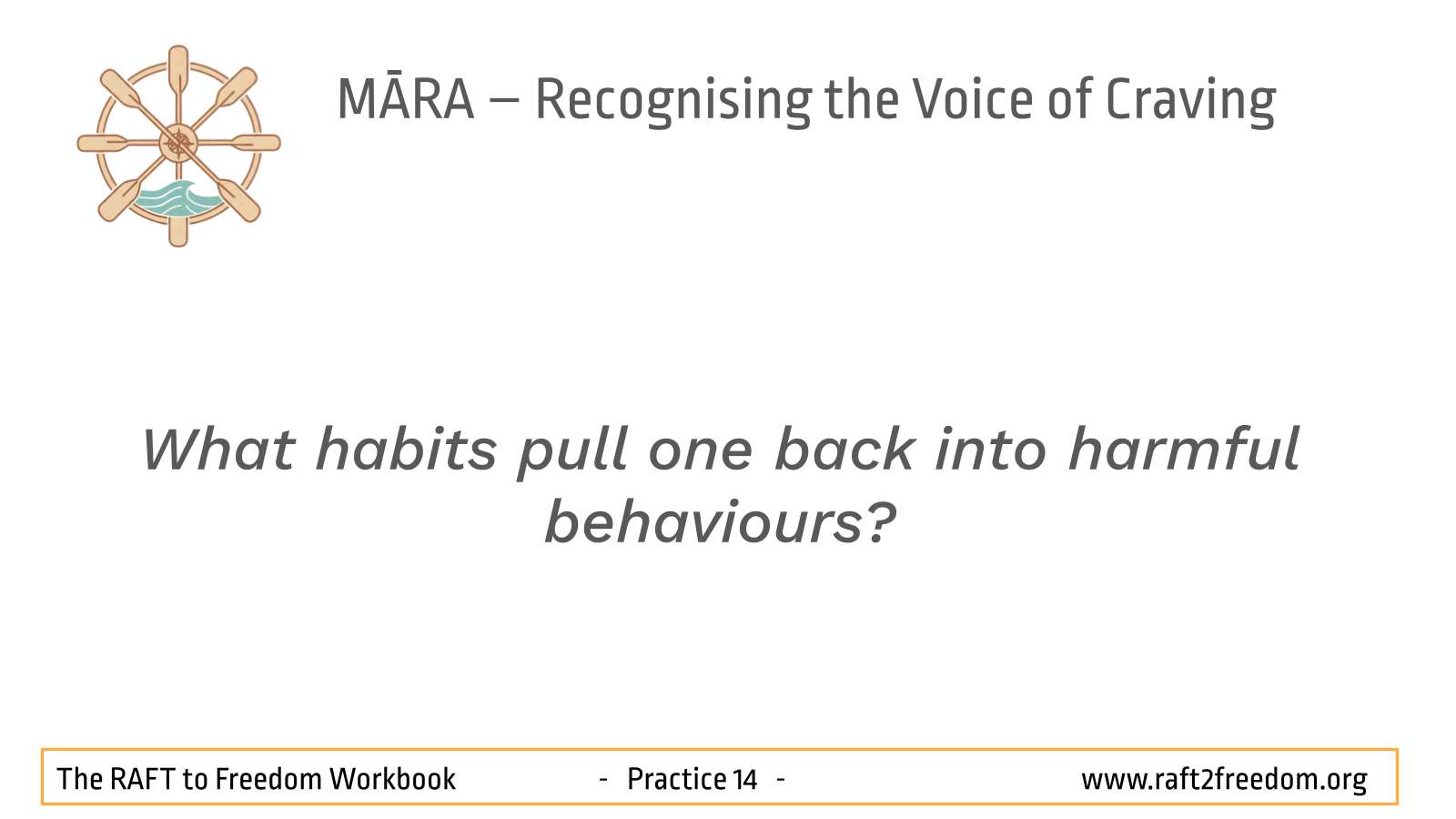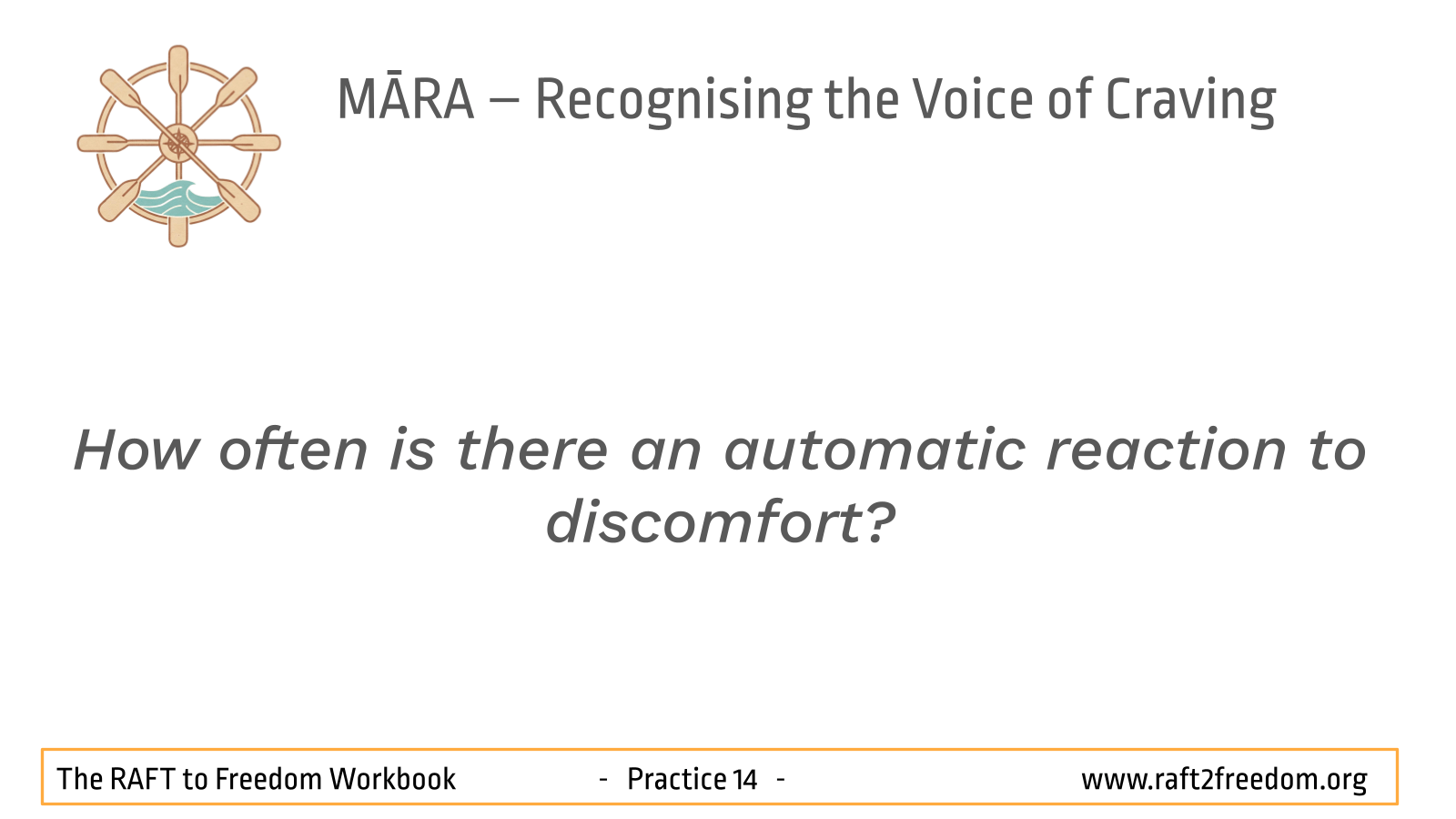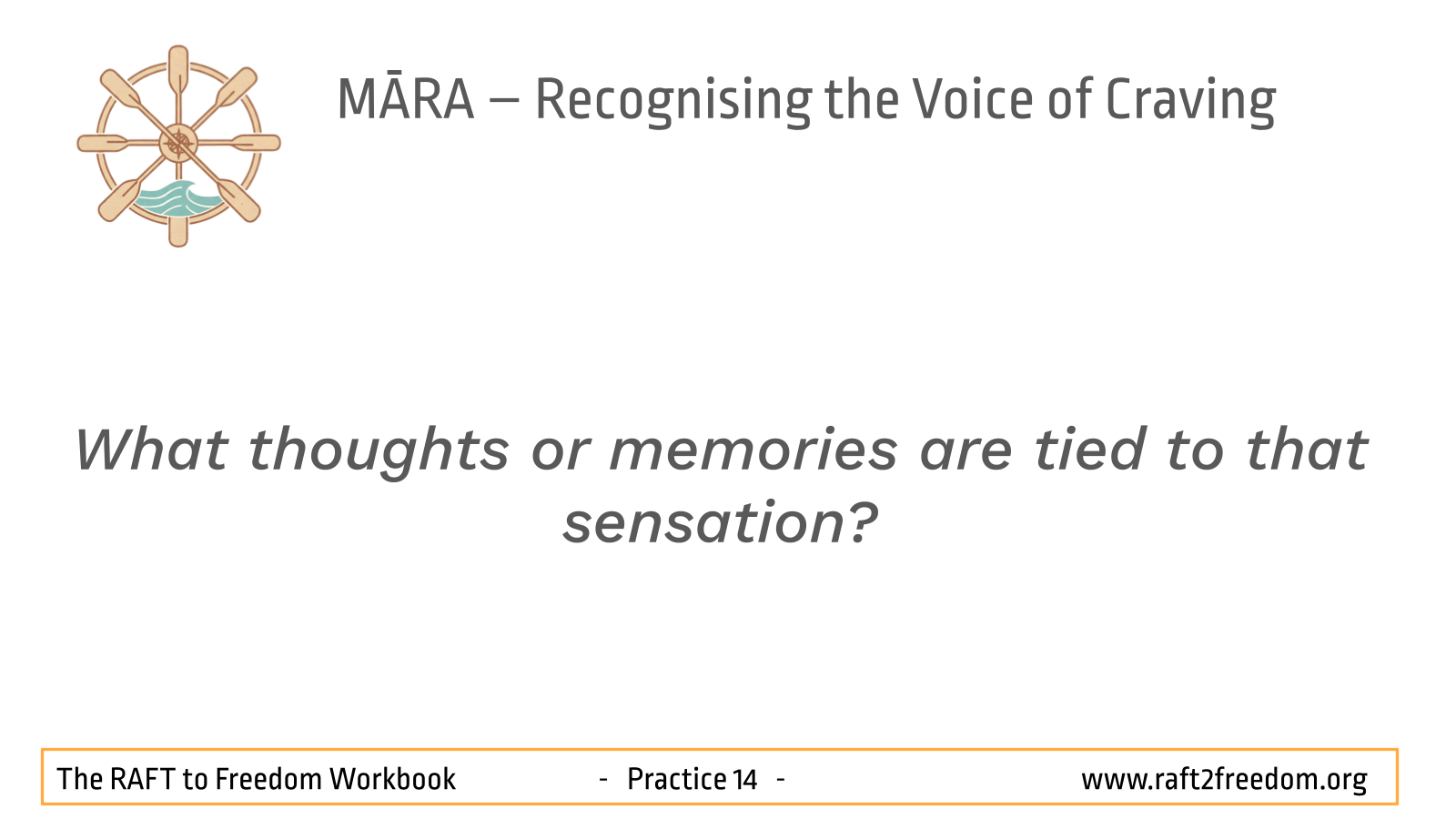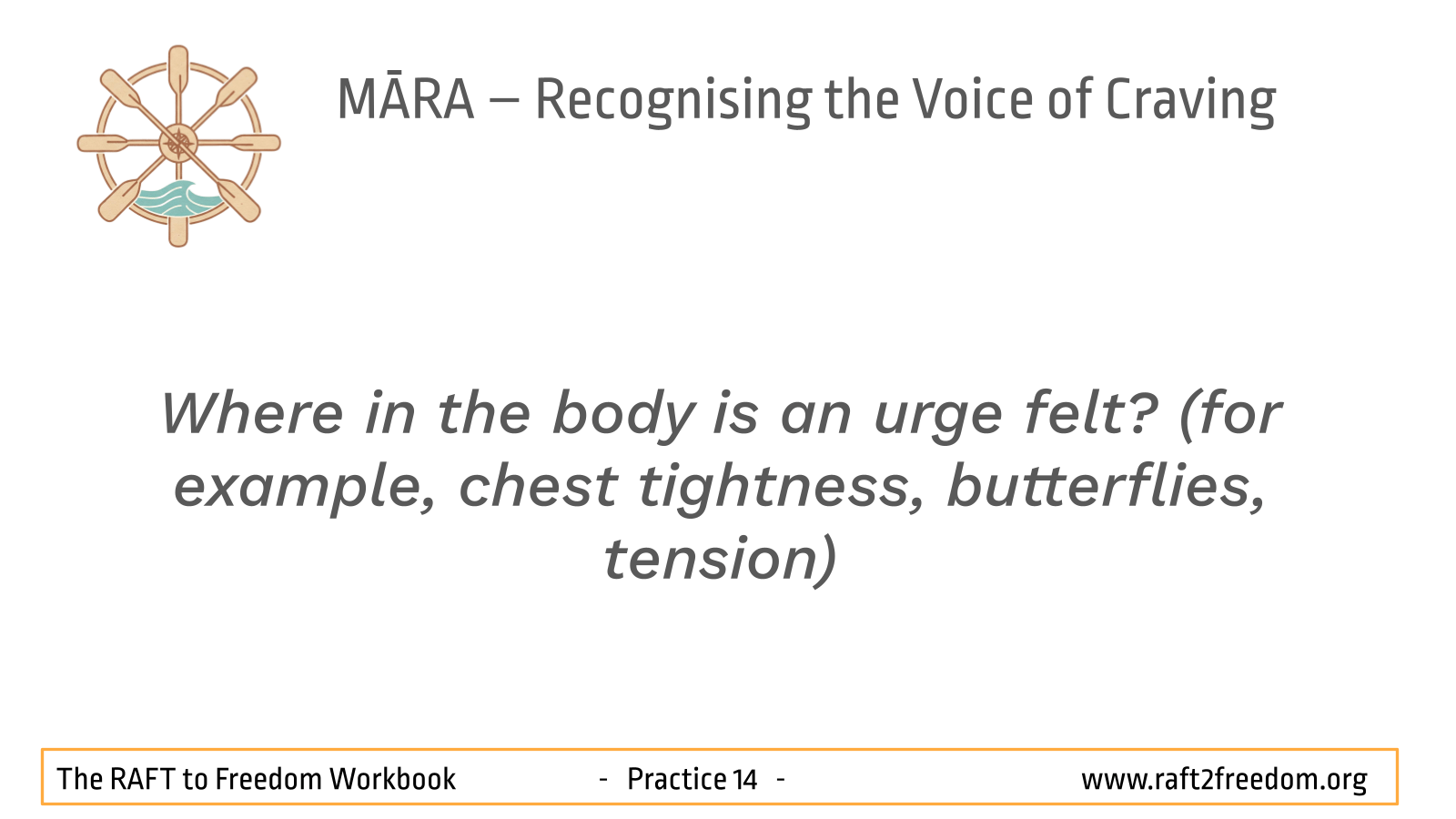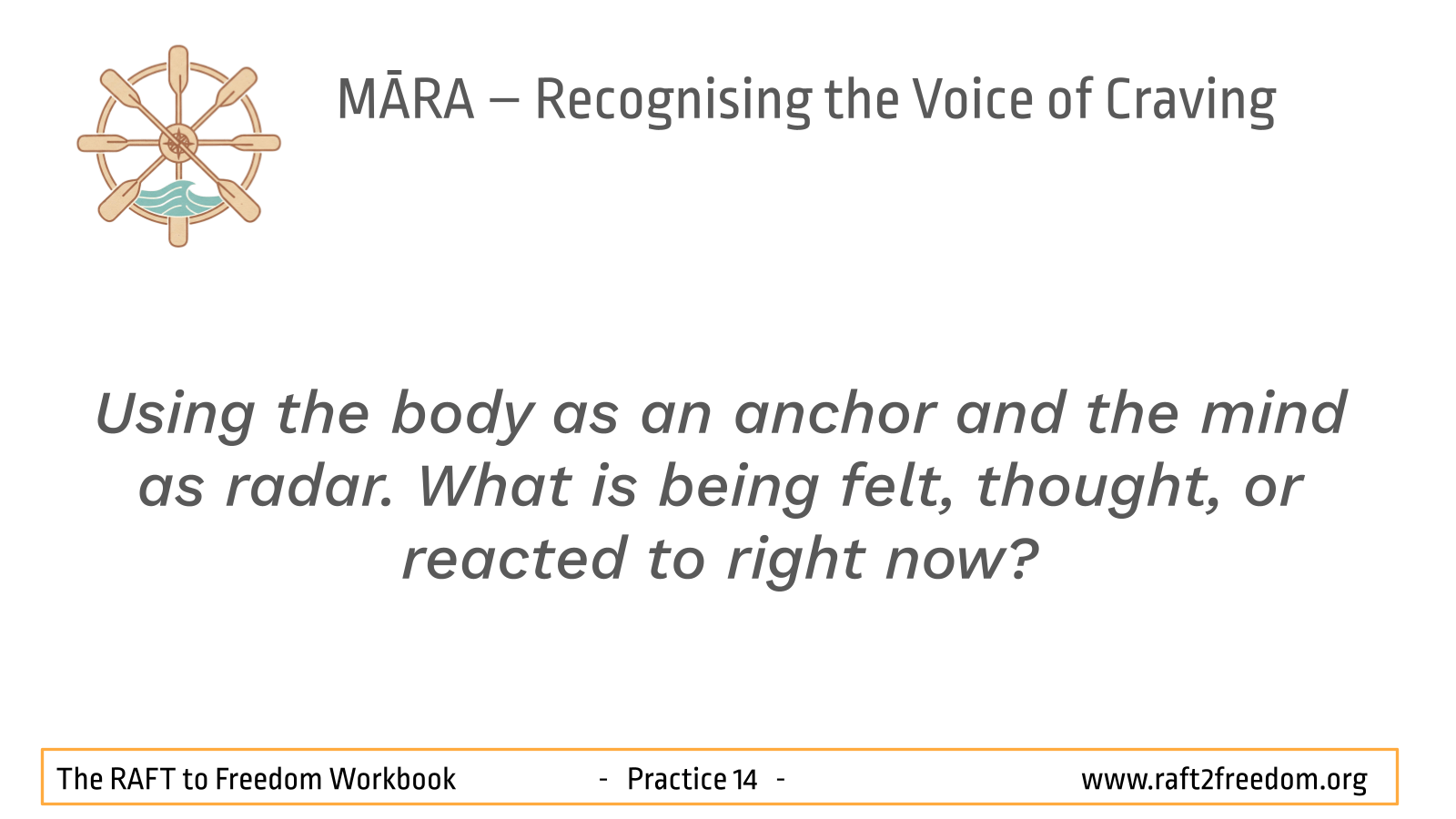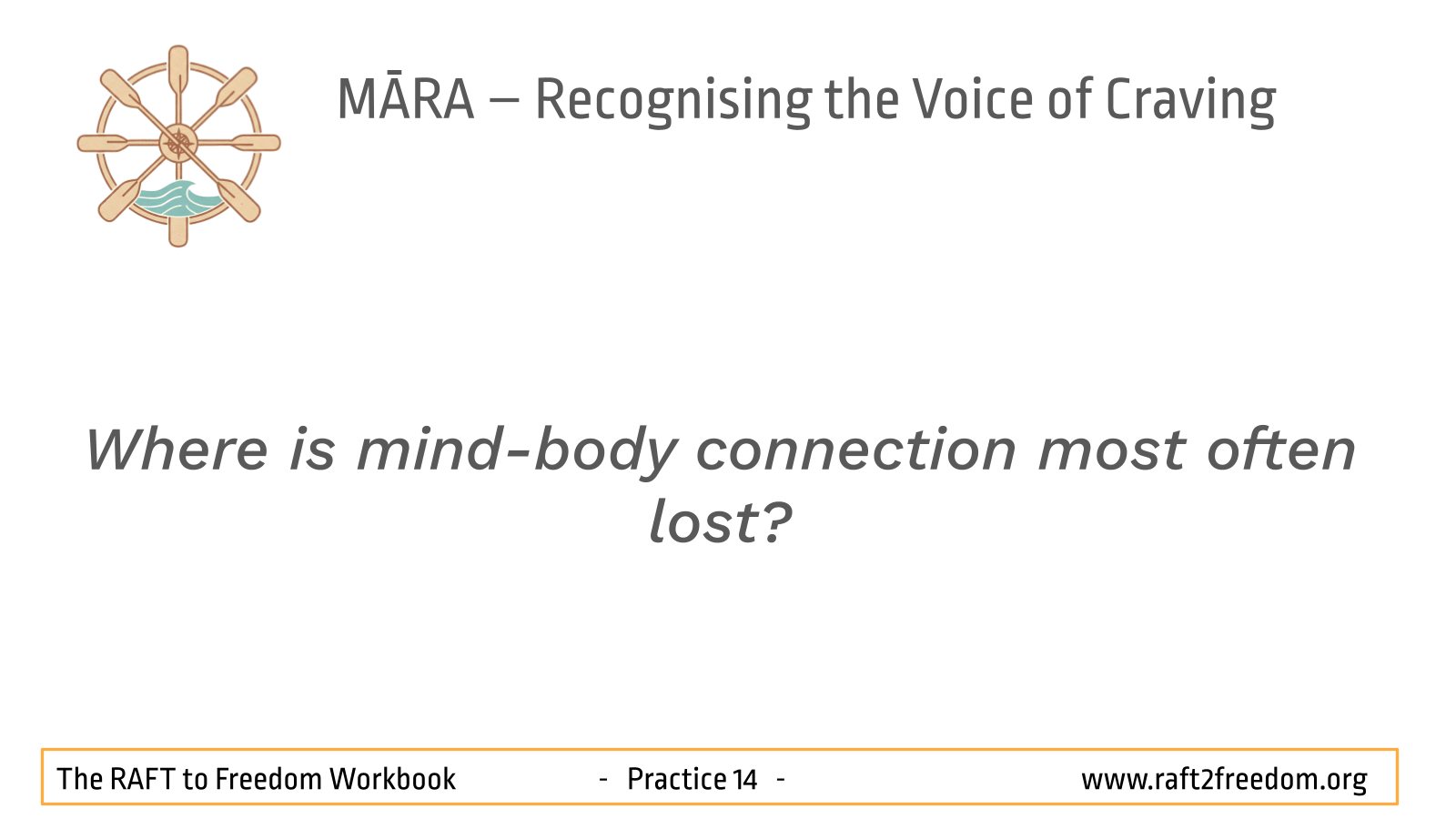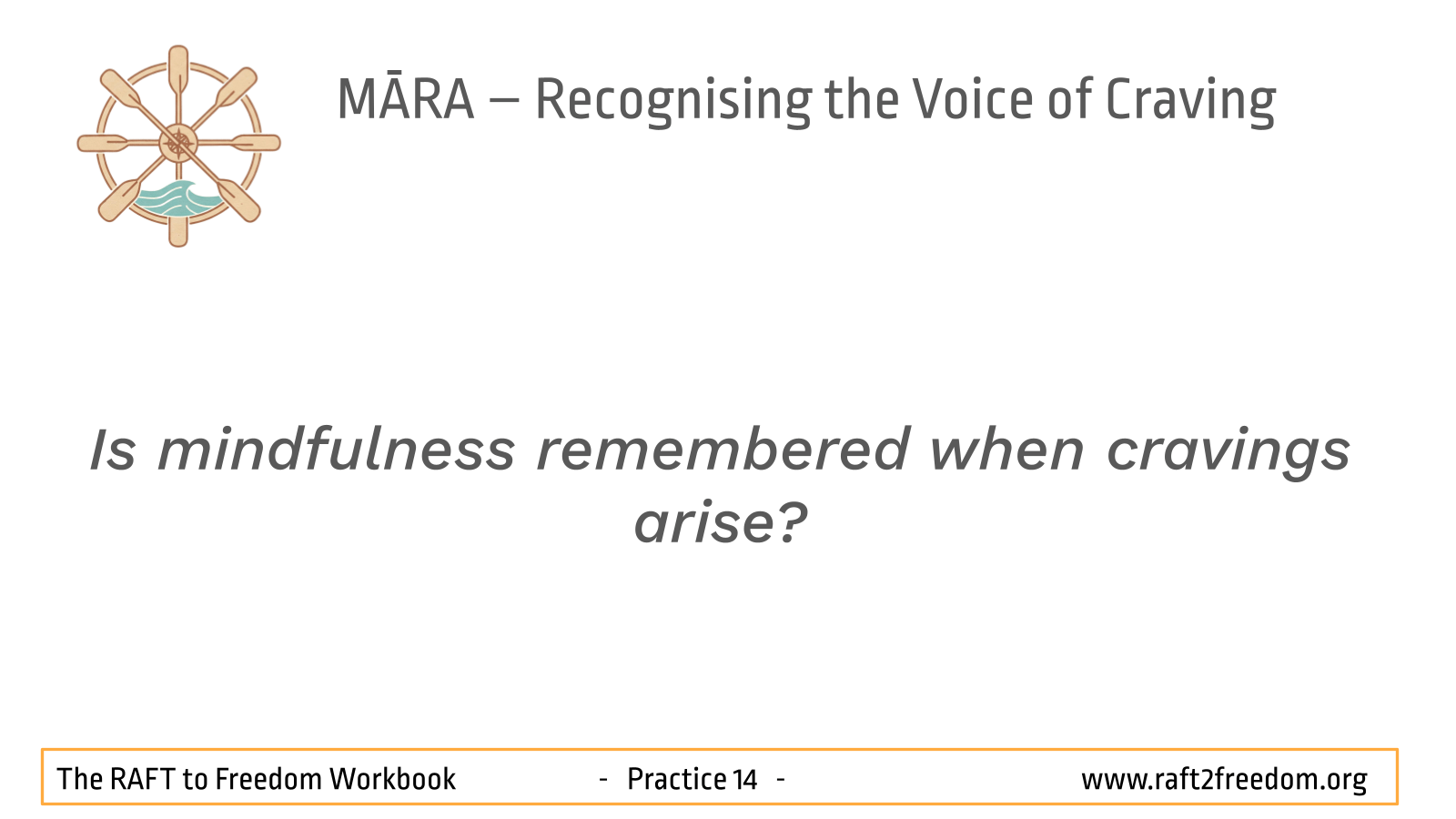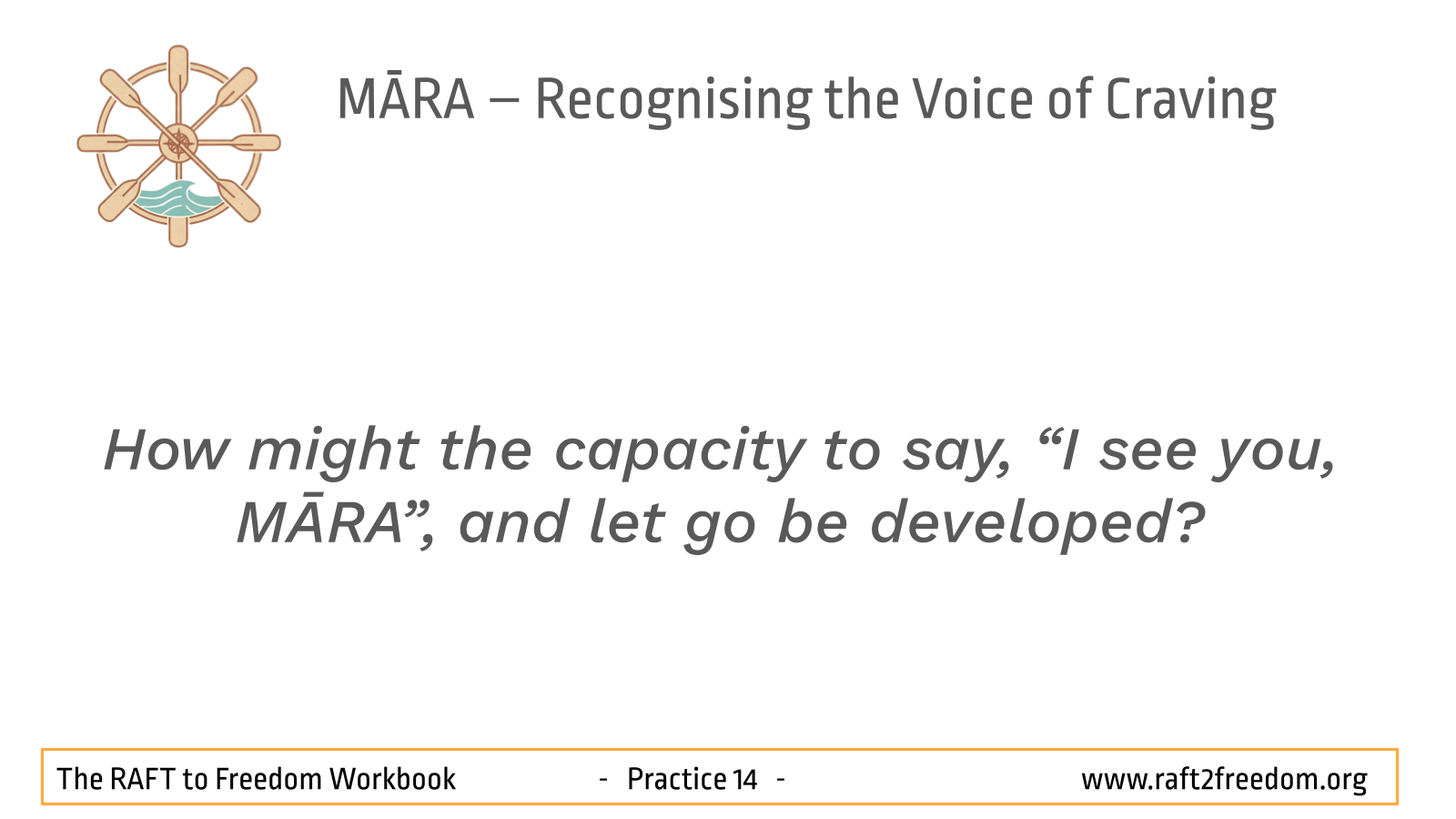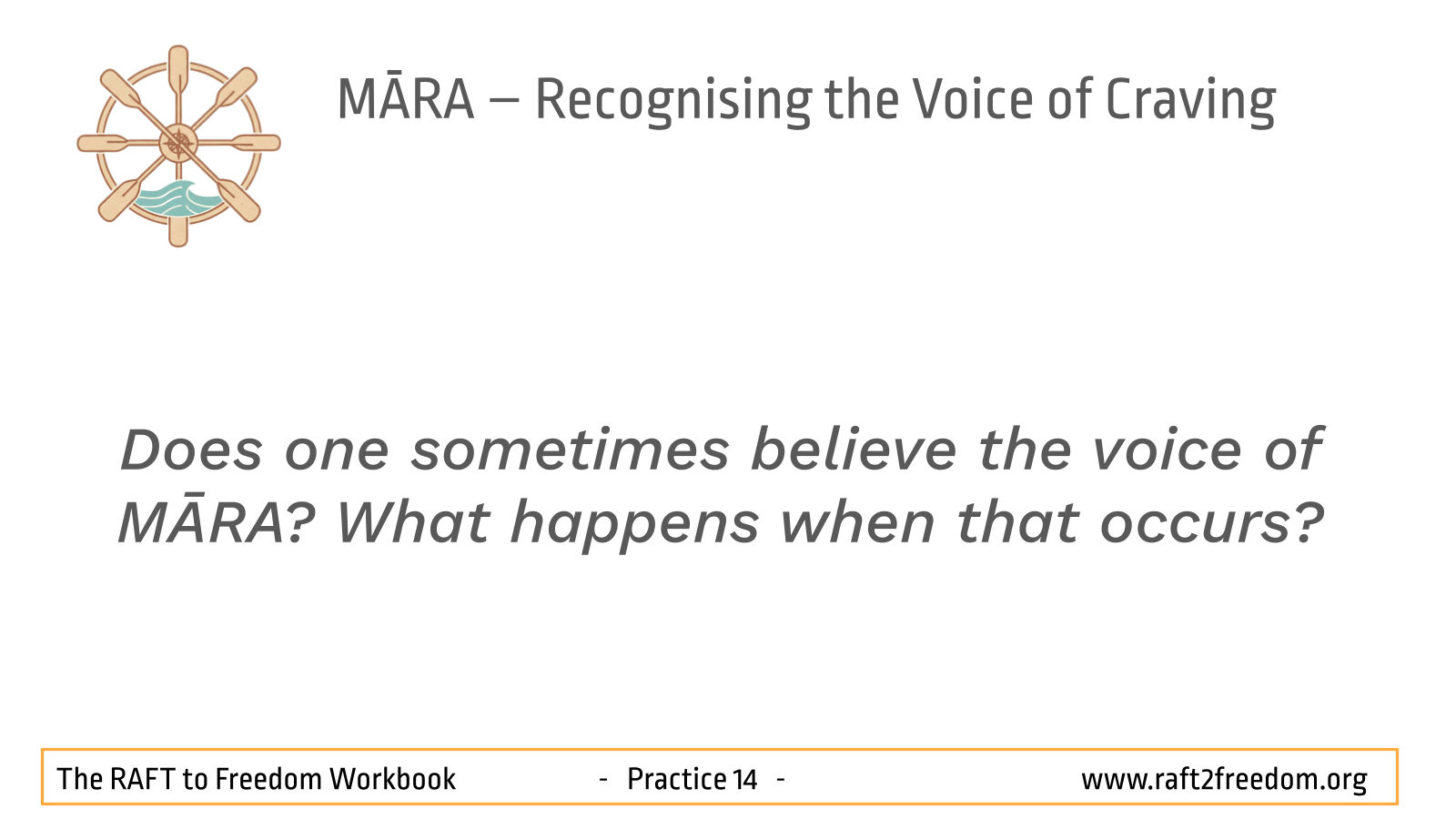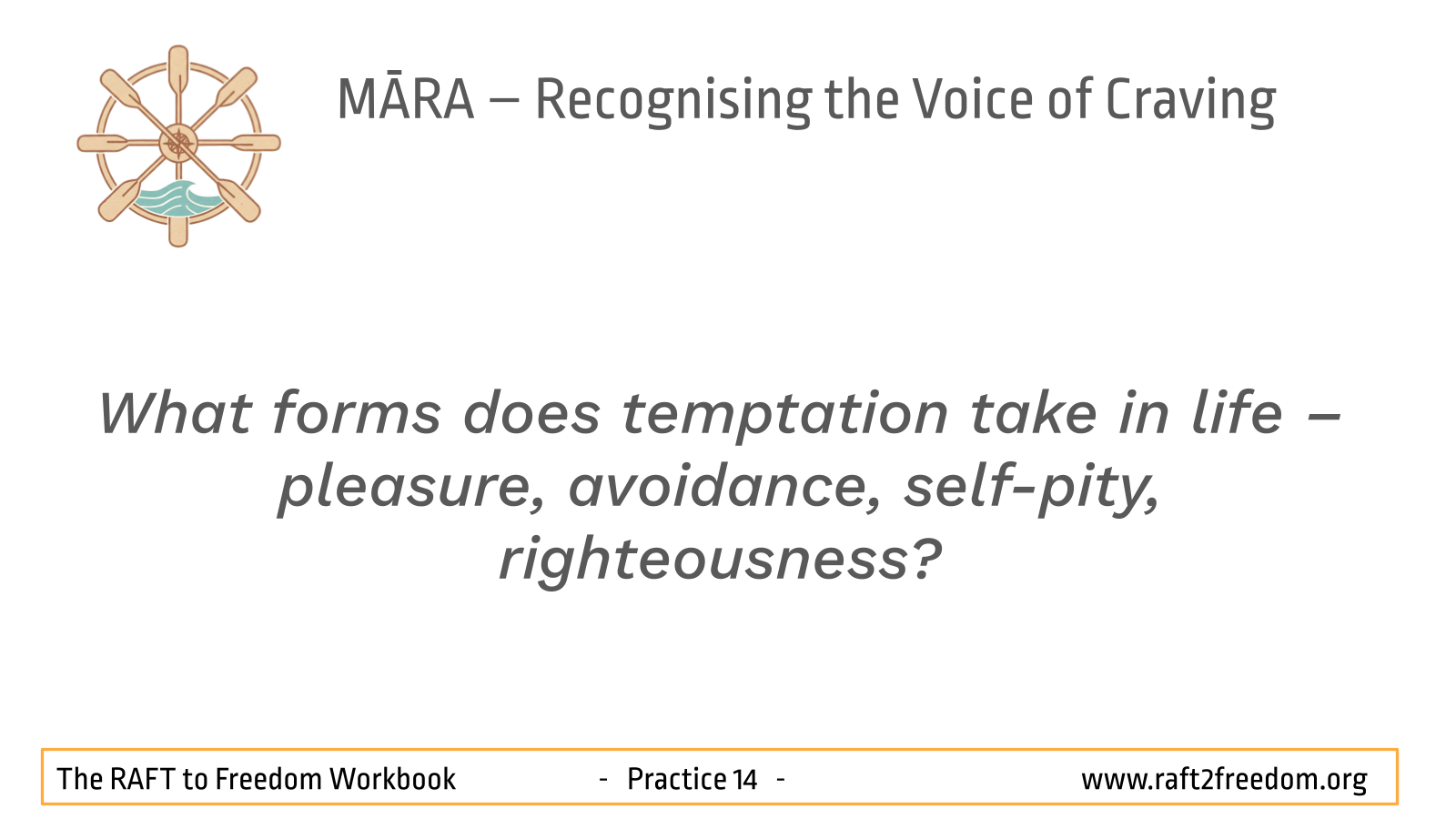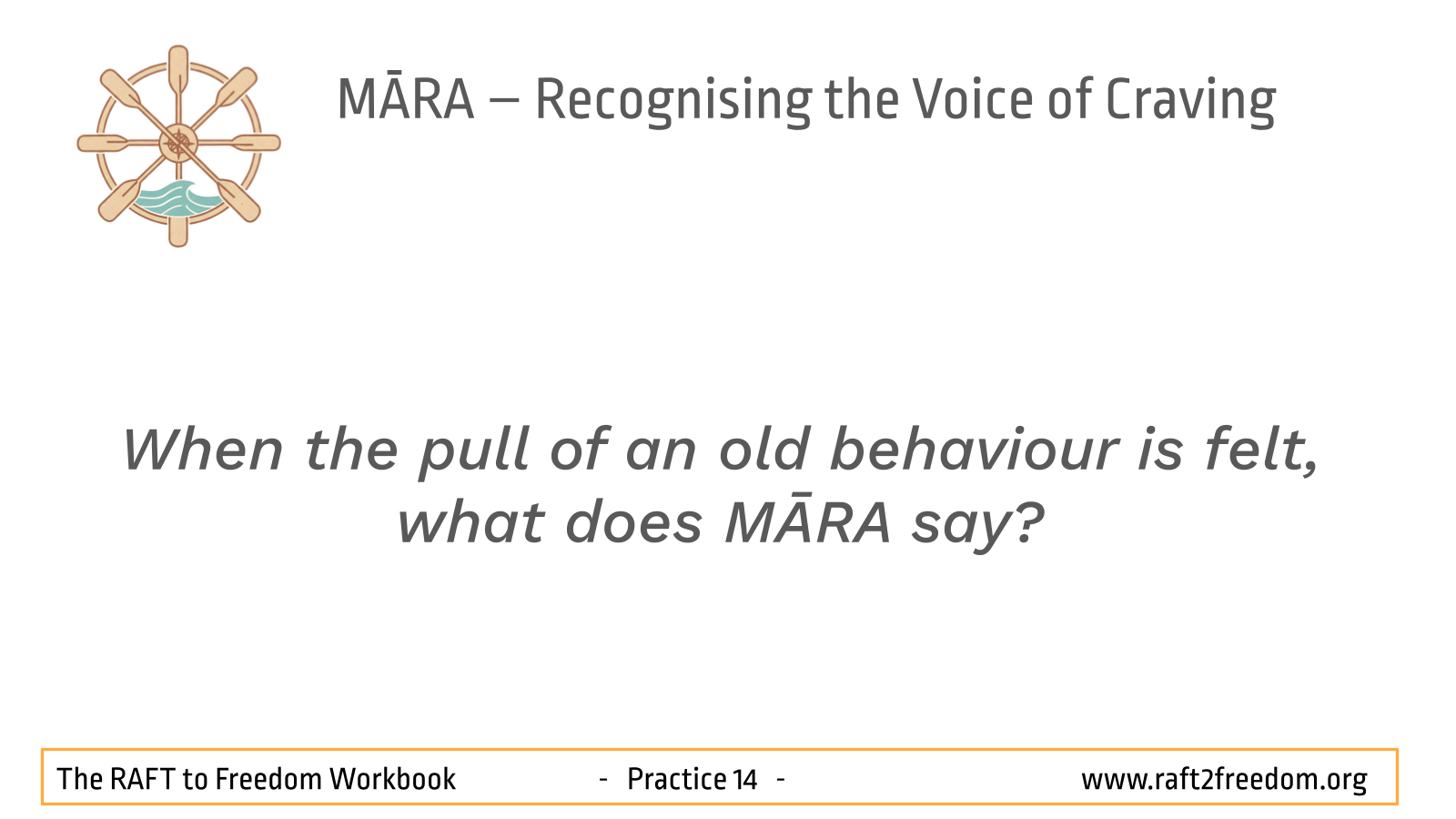Māra – I can see you,
RAFT to Freedom
Māra – I can hear you,
Māra – I can smell you,
Māra – I can taste you,
Māra – I can feel you,
Māra – I know you!
Practice 14 – “Māra, I See You”: Navigating the ongoing journey
Temptation and relapse: Guardrails against falling overboard
Knowing others is intelligence; knowing yourself is true wisdom. Mastering others is strength; mastering yourself is true power.
Lao Tzu
Where there is no perception of craving, there is freedom from suffering.
Adapted from a Buddhist Commentary
Māra – I can see you,
RAFT to Freedom
Māra – I can hear you,
Māra – I can smell you,
Māra – I can taste you,
Māra – I can feel you,
Māra – I know you!
“Māra never vanishes; he is always there, lurking. But for those who have opened their eyes, his power is broken. They see him and know him, and he cannot deceive them.”
Adapted from a Buddhist Commentary

Episode 14 – “Māra, I See You”: Navigating the ongoing journey
An AI generated ‘deep dive’ into this aspect of the RAFT to Recovery
As we continue our exploration within the ‘R’ for Recognising what it truly means to be human, we now turn our attention to a particularly cunning aspect of our inner world: Māra. We may have encountered tales of Māra in Buddhist teachings, often depicted as a personification of temptation and obstacles. Here, within the context of our journey to liberation, Māra is the perfect metaphor for the forces of craving, clinging, and reactivity or the personification of compulsion itself—subtle, cunning, and persistently trying to pull us off course.
This is not about battling some monstrous external force; instead, it is about learning to recognise, understand, and wisely relate to our internal patterns of thought, cravings, and compulsive behaviours. The person on the journey can think of Māra as those persuasive whispers in the mind that try to convince them to give in to old habits, rationalise unhelpful actions, or create doubt about the path to freedom. These are the hidden reefs and deceptive mirages that threaten to scupper our raft on our journey towards lasting peace.
Just as a vigilant navigator must learn to identify hidden dangers, we must learn to recognise Māra’s presence in his or her various disguises, if we are to steer our vessel to safety. What may have previously been unrecognised or subconscious urges and fears can now be clearly seen for what they are: the manifestations of Māra.
MĀRA: A mindful response
When old urges or self-defeating thoughts arise, we can pause, name the pattern, and say: “I see you, MĀRA.” This empowers us to respond mindfully rather than react automatically. We use the acronym MĀRA as a guide for this practice:
- Mindful: We bring present-moment recollection to our experience. Remembering to remember what we are doing and why we are doing it. This is the foundation of all mindful cultivation of well-being. As mindfulness scholar Jon Kabat-Zinn notes, mindfulness is “moment-to-moment, non-judgmental awareness”.
- Awareness: We cultivate awareness of what is happening right now – the sensations in the body, the emotions arising, and the thoughts that swirl in the mind. This is where the friendly curiosity of investigation can truly take the wind out of anxiety, cravings, and compulsions.
- Responds: Crucially, we learn to respond rather than merely react. We are not urges. This practice creates a vital space between the impulse and potential action.
- Appropriately: The response should be wise and kind, both to oneself and to the situation at hand. This often means meeting challenges with non-judgmental awareness and self-compassion rather than suppression or self-criticism. An appropriate response could be to engage a pre-planned coping strategy, seek support, or simply observe the urge without acting.
This act of recognition transforms the relationship with the craving, from being possessed by it, to simply observing it. It is the practice of seeing the patterns of escape and self-sabotage for what it is – an impersonal, conditioned pattern, not a true self. When a craving arises, when self-doubt whispers “craving’s message of not changing,” “the pull of compulsive and reactive behaviours have failed too many times,” or when avoidance beckons “this is not needed,” we can mentally say, “Ah, this is Māra. This is the voice of craving. I see you”. This naming restores our agency and reminds us that we are not our harmful habits.
“The adversary is the inner voice that whispers you cannot, or you must. It is the one that tells you lies to keep you in chains.” Anon
Gotama and Māra: A dynamic of recognition
In the early Buddhist texts, Māra is the personification of temptation, delusion, and death – the one who tries, again and again, to obstruct awakening. To the person on the journey, Māra is not an external demon, but the embodied force of harmful craving itself – appearing as craving, doubt, fear, denial, or distraction.
What is striking is that Māra appears more often after Gotama’s (the Buddha) enlightenment than before. Why? Because awakening does not remove temptation; it reveals it. With clarity comes recognition. Gotama no longer struggled with Māra; he simply saw him clearly, and named him: “I see you, Māra”. This profound insight aligns with the observation that Gotama’s heightened awareness after he woke up to the four realities, allowed him to perceive Māra in all his or her subtle disguises.
In cultivating well-being, this ability to see Māra – to name and disidentify from compulsive urges and self-defeating thoughts – is essential. It is the difference between being caught in a loop and stepping out of one. This story offers a profound re-framing of our internal struggle with the human struggle with craving and avoidance. Instead of a battle against a monstrous, external force, it becomes a process of recognising, understanding, and wisely relating to an internal pattern of thought, craving, and compulsion. This approach, characterized by calm awareness, compassion, and understanding, mirrors Gotama’s response and encourages us to meet our inner challenges with gentleness, fostering self-compassion rather than internal conflict.
Māra and our embodied awareness: the six lenses of mindfulness of body
Over the previous few chapters, we have practised Mindfulness of the Body and cultivated a stable base. We can use the six elements of Mindfulness of Body as powerful lenses to recognise Māra’s subtle manifestations within our own experience:
- Mindfulness of breathing and Māra: This foundational practice provides an immediate anchor, calming the inner agitation that Māra thrives on and helping us recognise the impermanent nature of cravings as they arise and pass. It helps us to see Māra’s subtle arrival. How does Māra affect breath? Does an urge or a self-defeating thought make breathing shallow, fast, or tense? Noticing this physical shift through mindful breathing is often the first clue that Māra is present, trying to pull us into reactivity.
- Mindfulness of posture and Māra: By cultivating awareness and stability in physical posture, we create an embodied sense of groundedness that counters the restlessness and instability Māra often brings. Observe posture. Do the shoulders slump when hopelessness whispers? Do the shoulders tense when craving arises? Body posture can be a mirror reflecting Māra’s subtle influence, indicating a shift in internal state.
- Clear comprehension and Māra: This skill directly supports our ability to say “I see you, Māra”. It allows us to pause and wisely choose how to respond to urges, rather than reacting automatically. We investigate cravings non-judgmentally, discerning their true nature. This is about seeing the purpose or intention behind Māra’s visit. What is the voice of craving trying to achieve? Is it promising relief, escape, or validation that ultimately leads to suffering? Clear comprehension helps us to see through the illusion.
- Mindfulness of the reality of the body and Māra: Grounding in the tangible sensations of the body helps dispel the mental fogginess and delusions that Māra uses to obscure our path. How does Māra manifest as physical sensations? Does it create a false sense of need, discomfort, or emptiness that only harmful habits promise to fix? By observing these sensations mindfully, we can recognise them as impermanent events, not urgent commands.
- Mindfulness of the elements and sensations of existence and Māra: Cultivating an awareness of awareness helps us observe Māra’s temptations, thoughts, and cravings as temporary mental events, fostering a non-reactive stance towards them. Connect to the fundamental elemental qualities (solidity, fluidity, temperature and movement) within the body. When Māra arises, where is the heat of anger felt, the fluidity of fear, or the heaviness of despair? Grounding in these basic sensations can prevent Māra from pulling us into mental narratives.
- Mindfulness of ageing/decay and Māra: This practice cultivates radical acceptance. By seeing that Māra’s temptations and all experiences are temporary, we reduce the clinging that fuels the subtle chains we all carry, diminishing Māra’s power over us. This is a deeper reflection. How does giving in to Māra accelerate the decay or suffering in one’s life – physically, mentally, or spiritually? This long-term perspective can disempower Māra’s short-term promises by revealing their true cost.
MĀRA and the RAFT to Freedom framework
The story of Māra offers us a profound framework for understanding and navigating our journey to liberation, explicitly built on Buddhist principles. It underscores why the RAFT framework is so essential:
- R – Recognise: “I See You, Māra”: Gotama’s primary advantage over Māra, especially after waking up to reality, was his ability to instantly recognise him or her in any disguise. By calmly stating, “I see you, Māra,” Gotama exposed the illusion and robbed it of its power. Importantly, he did not get angry or frightened; he simply acknowledged its presence.
This is the foundational step of mindfulness in cultivating well-being. This workbook guides us to Recognise the craving or compulsive thought as it arises, without judgment. Instead of being swept away by it, we can learn to mentally say, “Ah, this is Māra. This is the voice of craving. I see you”. This act of recognition creates a crucial space between impulse and action and changes our relationship from one of possession by the urge to one of observation of the urge. It is the practice of seeing the patterns of escape and self-sabotage for what it is – an impersonal, conditioned pattern and not our true self.
- A – Abandon: Understanding Māra’s intentions so that we can ‘Let Go’: Gotama defeated Māra not by destroying him, but by understanding the nature of his tools – desire, aversion, doubt, fear – and thereby abandoning the mental confusion that Māra represents. He saw the intention behind the temptation and chose not to engage.
This RAFT model focuses on Abandoning harmful cravings. The Māra story enriches this by showing us how. By understanding Māra’s intentions to pull us back into suffering and delusion – to abandon ship and jump overboard – we can see the true intention of our compulsive urge: it promises relief but delivers only more suffering. This insight is the motivation helping us to abandon the behaviour. It’s not about white-knuckling through a craving, but about seeing its empty promise so clearly that the desire to follow it withers. We abandon the compulsion by abandoning the illusion that it offers a real solution. This deepens our understanding of non-aversion, fostering a response of compassionate curiosity to the arising craving itself, thereby lessening its power.
- F – Freedom: the peace of non-engagement: After his awakening, Gotama was not free from Māra’s visits, but he was free from being disturbed by them. His peace was unshakable because Māra had no power over his mind. This is the nature of Freedom (Nirvana) – not a place, but the extinguishing of the fires of greed, hatred, and delusion that Māra represents.
The F in RAFT stands for Freedom, which is the direct experience of being free from craving’s grip. The Māra narrative teaches us that freedom is not the absence of triggers or compulsive thoughts. Freedom is when those thoughts arise, are recognised (“I see you, Māra”), and have no power over us. This workbook includes exercises that help us learn to savour and appreciate these moments of Freedom – the peace that comes from not acting on an urge. This builds a positive feedback loop, reinforcing our motivation to continue on our journey.
- T – Train: The Lifelong vigilance of mindfulness : Gotama’s story shows that Māra never completely vanishes; he makes appearances throughout Gotama’s life. This highlights that our path requires continuous cultivation and training. Gotama’s consistent, calm awareness was his ongoing practice.
RAFT concludes with Train, which involves using the Eightfold Path as a comprehensive programme for living. We will consider the Eightfold Path in detail further along our journey. The Māra story underscores why this training is essential. The journey to liberation is not a one-time event but a continuous practice of training our heart and mind. We train in mindfulness to keep recognising Māra, train in wisdom to remember the consequences of following him or her, and train in ethical conduct to build a life where Māra finds less fertile ground to sprout. This perspective transforms vigilance from a stressful, hyper-alert state into a calm, patient, and compassionate practice of self-awareness.
Inviting Māra to tea
A popular teaching from modern Buddhist psychology, inspired by this narrative, is inviting Māra to tea. Instead of fighting or suppressing difficult emotions and cravings that Māra represents, we mindfully acknowledge their presence, allowing them to be there without acting on them, and investigating them with compassionate curiosity. This approach aligns well with Judson Brewer’s insights on ‘hacking the brain for habit change’ and the idea of responding with ‘that’s interesting’ rather than automatic reactions.
“The difference between a habit and a choice is awareness. When you’re aware, you have the power to choose. When you’re not, you’re just reacting.” – Dr. Judson Brewer, The Craving Mind
Here’s how we might approach this practice:
- Role: One is the calm host – the mindful, wise self.
- Audience: The unexpected visitor – the craving, the difficult emotion, the voice of craving itself.
- Format: This can be a written dialogue or a silent reflection.
- Topic: One might say or write, “What is wanted? What is feared? Māra is seen, and will not be allowed to take over, but is willing to listen before letting go”.
For Example:
- Host: “Welcome, Māra. Māra is seen here, that familiar urge for a distraction. What brings Māra here today?”.
- Māra (the urge): “Māra just wants to feel better. Boredom is present. This will make it go away, just for a little while”.
- Host: “Māra’s desire to feel better is understood. That impulse is appreciated. But Māra’s ‘solutions’ lead to more pain. Thank you for visiting. Māra is seen, and the choice is to remain present”.
By incorporating the story of Gotama and Māra, the RAFT programme offers a deeply compassionate and empowering framework, shifting the paradigm from a war against oneself to a journey of profound self-awareness and liberation.
How to practise the mindful Māra pause
Next time an urge or unhelpful thought arises, follow these steps:
- Pause, come into the body.
- Mindful – recall the present moment.
- Awareness – note any sensations, thoughts or emotions.
- Respond – label it MĀRA or compulsive impulse.
- Appropriately – choose a wise response – take a few mindful breaths, call a friend, or do a body-scan.
A short Māra meditation
Sit quietly and let the breath settle. When a thought or craving arises, ask gently, “Who is this?” See if it has the quality of wanting, doubting, or fearing. Silently name it, “Māra.” Smile inwardly, not with hatred, but with recognition. Say softly in the mind, “I see you, Māra.” Then return to the breath.
This meditation restores power not by suppression, but by clear seeing. Recognition weakens the pull of compulsive and reactive behaviours’ hold.
Self-Reflections
Approach these reflections gently, with self-compassion:
- When the pull of an old behaviour is felt, what does MĀRA say?
- What forms does temptation take in life – pleasure, avoidance, self-pity, righteousness?
- Does one sometimes believe the voice of MĀRA? What happens when that occurs?
- How might the capacity to say, “I see you, MĀRA”, and let go be developed?
- Is mindfulness remembered when cravings arise?
- Where is mind-body connection most often lost?
- Using the body as an anchor and the mind as radar. What is being felt, thought, or reacted to right now?
- Where in the body is an urge felt? (for example, chest tightness, butterflies, tension)
- What thoughts or memories are tied to that sensation?
- How often is there an automatic reaction to discomfort?
- What habits pull one back into harmful behaviours?
- What is the most wise and compassionate choice right now?
- Who or what helps take that action (for example, a wise friend, a mentor, meditation, walk)?
Journaling Prompts
Explore these themes in writing, remembering to be kind to oneself:
- Seeing Māra clearly: “I see you, MĀRA when…”: List five recent times a compulsive urge, thought, or story pulling off the path of cultivating well-being was noticed.
- Recognising Māra’s disguises: Reflect on how the human struggle with craving and avoidance presents itself now. Is it craving, boredom, irritation, busyness, or superiority?
- A conversation with Māra: Write a short imagined dialogue between oneself and MĀRA. What does Māra say? How does one respond?
- Naming the trickster within: Give the mind’s voice of craving a name or identity. When it arises, how can it be gently, playfully disarmed?
- Mindfulness in action: Write a moment from today when mindfulness saved – or could have saved – a situation.
- When the pause was lost: Describe a time when the pause was forgotten, and what happened then.
- Mapping the urge: Record an urge’s location, intensity, and associated thoughts. Review patterns – when and where do urges typically arise?
Breaking the habit loop: List automatic reactions and consider alternative responses. - Unhooking from thought: Practice defusion: rewrite a self-judging thought as “I notice the thought that…”
- Building a response toolkit: Design a ‘response toolkit’: 3-5 mindful tools that can be used when MĀRA appears.
- Moments of Appropriate Action: Reflect on a recent time a wise action was taken – how did it feel?
Supporting material: scientific and philosophical perspectives
For those interested in the scientific and philosophical underpinnings of MĀRA, the following overview highlights some key connections.
- Neuroscience: Neuroscience shows that cravings activate specific brain regions like the insula and anterior cingulate – areas tied to interoception (awareness of internal bodily states) and urges. Dopaminergic systems in the brain respond intensely to cues associated with the pull of compulsive and reactive behaviours, even without the external stimulus present. Māra is that anticipatory signal – the mental formation preceding falling overboard. The DMN (associated with self-referential thought) is hyperactive in rumination, craving, and story-making. Māra often appears with stories: “Patterns of escape and self-sabotage will never change,” “This experience is not like others,” “One last time…”.
In Mindfulness-Based Relapse prevention (MBRP), practitioners learn to notice triggers and choose new responses. In Acceptance and Commitment Therapy (ACT), we defuse thoughts – seeing them as mere mental events, not truths. Neuroimaging further shows that mindfulness reduces activation in craving-related brain areas.
- Psychology: From an evolutionary perspective, craving is wired into the limbic system to ensure survival through food, sex, and social belonging. Māra exploits these ancestral tendencies in modern environments with supernormal stimuli (for example, drugs, alcohol, pornography, gambling). Brains evolved to seek safety and pleasure – Māra hijacks that mechanism with modern stimuli. Freedom arises when deliberate action is chosen over instinctive reactivity.
- Philosophy: Philosopher Søren Kierkegaard described a pervasive ‘sickness of despair’ – not knowing one’s true self – which, seen through a Buddhist lens, is Māra’s domain. In Buddhist terms, Māra is the fear of letting go of the false self – of freedom itself. This philosophical perspective reinforces the idea that Māra’s power lies in keeping us trapped in patterns of self-deception and attachment to what is familiar, even if it causes suffering.
Closing Remarks
Recognising Māra, the voice of the human struggle with craving and avoidance, is a crucial step in our RAFT to Freedom journey. It is about developing the wisdom to read our inner map accurately, identify these hazards when they appear, and learn skillful means to avoid being shipwrecked by them. By patiently and persistently consulting our internal map through mindful awareness and using our navigational skills, we learn to sail through these hazardous waters towards the calm harbour of freedom.
This chapter has equipped us with powerful ways to recognise Māra’s subtle influence, to greet it with the clear, empowering phrase, “I see you, Māra,” and to choose our response wisely. This ongoing vigilance, supported by our growing awareness and compassion, is a vital guardrail against falling overboard. It allows us to strengthen our raft and ensure we continue on our purposeful journey towards the safe shore.
Remember to remember
Māra is not something to fight but someone to see. His or her power is invisibility or disguise. Gotama did not destroy Māra; he disempowered him by naming him – again and again. We, too, can learn this art: To say, “I see you, Māra” and walk on.
Recognition, rather than fighting, is the key to disempowering Māra, allowing the journey to continue with clarity and purpose. By continuously acknowledging Māra without engagement, the subtle chains of craving begin to loosen, revealing the path to liberation. This mindful approach allows us to meet the arising urges with self-compassion and curiosity, preventing them from gaining a foothold and steering us off course. Our sustained awareness is the very force that dissolves Māra’s deceptive power, enabling us to choose freedom moment by moment.
The moment you recognise your cage, you are already free. The rest is simply walking out.
Rumi
The wisest warrior knows when to pick up the sword, and when to simply see the illusion.
Thich Nhat Hanh
Sutta References
- Samyutta Nikaya 4.1: Māra, I See You
- Summary: This Sutta contains the powerful phrase “I see you, Evil One,” spoken by the Buddha to Māra. It highlights the Buddha’s clear insight and recognition of Māra’s deceptive nature, which immediately disempowers Māra’s attempts at obstruction. This is directly relevant to recognising cravings without being ensnared by them, a core theme of the chapter.
- Majjhima Nikaya 105 (Salha Sutta): The Surgeon’s Probe
- Summary: This Sutta uses the simile of a surgeon’s probe and knife to illustrate how mindfulness and wisdom are applied to remove craving and ignorance, likened to extracting an arrow. It supports the concept of mindful investigation and skilful response to internal urges, rather than mere reaction.
- Majjhima Nikaya 19 (Dvedhavitakka Sutta): Two Kinds of Thinking
- Summary: This discourse discusses the practice of cultivating wholesome thoughts and abandoning unwholesome ones by reflecting on their consequences. It underscores the importance of mindful awareness in distinguishing between thoughts that lead to suffering and those that lead to liberation, directly relating to the choice we make when recognizing Māra.
- Samyutta Nikaya 46.55: Overcoming Hindrances
- Summary: This Sutta compares the overcoming of hindrances (which Māra often represents) to being freed from debt, sickness, prison, slavery, and a perilous wilderness, leading to rejoicing and gladness. It reinforces the liberating effect of recognizing and abandoning the forces of craving and aversion.
- Satipaṭṭhāna Sutta (MN 10): The Foundations of Mindfulness
- Summary: This foundational discourse guides practitioners to use mindfulness to know when hindrances (such as craving, ill-will, sloth, restlessness, and doubt, all aspects of Māra) are present or absent. It provides the detailed methodology for the “Recognise” stage by cultivating clear, non-judgmental awareness of internal states, essential for seeing Māra for what he is.
| RAFT to Freedom © 2025 by Dr Cathryn Jacob and Vince Cullen is licensed under CC BY-NC-SA 4.0. To view a copy of this license, visit https://creativecommons.org/licenses/by-nc-sa/4.0/ |
